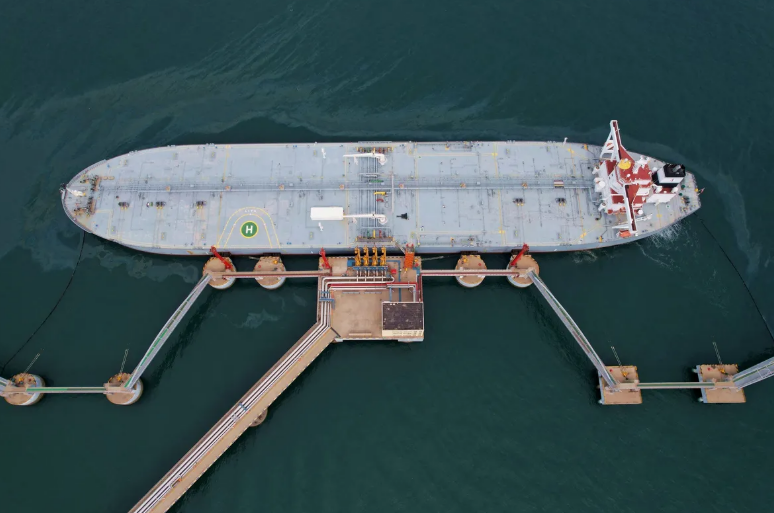
Washington sanctions Chinese terminal for imports Iranian oil disguised as a malaia load and expands tension amid the offensive against the Tehran regime
The United States government announced on Wednesday (30) a new round of economic sanctions, this time directed to a Chinese oil terminal that would have received multiple Iranian cross. The measure is part of the American strategy to contain Iran’s energy exports, which according to Washington would fund terrorist activities around the world.
The sanctioned company went to Zhoushan Jinrun Petroleum Transfer Co., located in the city of Zhoushan, one of the main industrial regions of China and home to some of the largest refineries in the country. According to an official statement from the US State Department, the company received at least six raw oil remittances from Iran.
Read too
Family Mode Transforms Tiktok into children’s mirror
Powerdate shows that 46% blame the Bolsonaro family for tariff
Nvidia is called to explain in the Beijing Court
The list of sanctions released includes 20 entities involved, according to US authorities, in a network that facilitates energy trade between Tehran and other countries, even in the face of international restrictions. Attempts to contact Zhoushan Jinrun did not answer until the publication of this report.
This is the fourth Chinese installation to be penalized by the US due to activities related to Iranian oil. Biden administration has reinforced its “maximum pressure” stance against Iran, especially in relation to raw exports, considered one of the main sources of financing of the nuclear program and groups considered terrorist in the West.
In recent months, the United States had already imposed sanctions on several tank ships and individuals accused of participating in the illegal transport of Iranian oil. Some of the so -called Teapot refineries – China’s smaller independent units – had also been the target of similar punitive measures.
Although Beijing has officially interrupted Iranian oil imports since June 2022, outsourced providers and market information indicates that energy flow remains active. A common practice has been the boarding of Iranian loads under false identity, often labeled as originating from Malaysia.
Zhoushan Jinrun itself has significant storage capacity, according to information available on its corporate website: 1.095 million cubic meters, equivalent to approximately 6.9 million barrels of oil. Infrastructure can represent a strategic point in the energy distribution chain that attempts to circumvent international sanctions.
The new wave of economic restrictions illustrates the complexity of global trade relations and the difficulty of completely monitoring commodity flows in an international market increasingly adaptable to geopolitical pressures. While the US intensifies its campaign to economically isolate Iran, allies like China face the challenge of balancing commercial interests with the demands of international diplomacy.
For experts, the effectiveness of these sanctions increasingly depends on cooperation between allies and the ability to identify alternative routes that try to circumvent the restriction system. The inclusion of infrastructures such as Zhoushan’s demonstrates that Washington is expanding its focus beyond the sea carriers and directly aiming at the reception and processing points of these loads.
With these measures, the United States reinforces its message that any involvement with Iranian energy trade will be treated with rigor, even if it means placing traditional trade relations with strategic partners such as China.
Despite the restrictions imposed by the United States, some of China’s largest port terminals continue to receive significant Iranian oil loads, keeping a trade that moves billions of dollars alive and reveals the limitations of US sanctions against Tehran.
From January to June this year, facilities located in important maritime centers such as Qingdao, Dalian and Zhoushan helped Beijing acquire almost 1.4 million barrels per day of Iranian oil, according to data from Kpleler specialist consultancy. The figure represents a considerable volume, especially when it is considered that Beijing officially suspended imports of this type of energy since mid -2022.
In June alone, the ports of the Qingdao region received approximately 15.5 million barrels of Iranian cross – the equivalent of about $ 1 billion with current market prices. The course of these loads involves vessels already sanctioned by the US, which are used at different stages of the crossing between the Persian Gulf and the Chinese Terminals.
The pattern repeats itself along the eastern coast of the Asian country, with ports such as Dongjiakou and Lanqiao also recording Iran’s oil discharges. This commercial persistence illustrates both China’s energy need and the complexity of monitoring supply routes in an increasingly adaptable global market.
The Chinese posture in the face of sanctions reflects a pragmatic approach to the contradictory messages from Washington. While the Trump government has promised “maximum pressure” about Iran-even bombing nuclear facilities-the US president also publicly stated that China could continue to negotiate oil with Tehran.
This ambiguity has been used by local companies and operators seeking to maintain profitable commercial flows, even in the face of risks. Although Beijing does not officially recognize the unilateral sanctions imposed by the US, large corporations with international presence often adopt a more cautious stance, fearing being excluded from Western markets if they are directly involved with sanctioned entities.
Earlier this year, the ports of Shandong province received guidance from their controller to maintain sanctioned vessels away from their facilities – a measure that demonstrates the sensitivity of large companies in the face of American inspection.
To date, the US Treasury Department has focused mainly on the tanker vessels and operators involved in transportation, avoiding including large ports and Chinese refinery. The only exception was a Dongying terminal, also in Shandong, which was sanctioned for receiving Iranian cargo – a decision interpreted by the sector as a deliberate message to prevent collateral damage in other strategic areas.
Flow persistence is also linked to the growing demand from China by discount oil. With the Chinese economy facing lower and smaller refining margins, the country’s private refineries have actively sought for cheaper barrels to maintain their competitiveness in the domestic market.
Officially, the data from Chinese customs indicate that the country has not imported a single drop of Iranian oil since 2022. In practice, however, Tehran’s original raw is usually transferred at sea, often in the waters of Malaysia, where vessels sanctioned by the US deliver to other ships – often part of the so -called “dark fleet” – which complete the trip to the ports to the ports. Chinese.
This maritime transfer strategy has allowed both countries to maintain important trade relations, even in the face of international pressure. For experts, the phenomenon reveals the limitations of unilateral sanctions in a world where commercial routes quickly adapt to the restrictions imposed.
Meanwhile, China faces growing pressures to diversify its international payment mechanisms, with consultants suggesting the use of stablecoins to circumvent dollar hegemony. At the same time, Israel continues to ask China to use its economic and political influence to contain Iran’s nuclear and military ambitions.
Given this complex scenario, data from the early months of 2025 indicate that oil trade between China and Iran remains resilient – a demonstration that sanctions, however rigorous, find limits when they bump into strategic economic interests of global powers.
With information from Bloomberg*
Source: https://www.ocafezinho.com/2025/07/31/eua-atacam-terminal-chines-e-acirram-guerra-do-petroleo/

